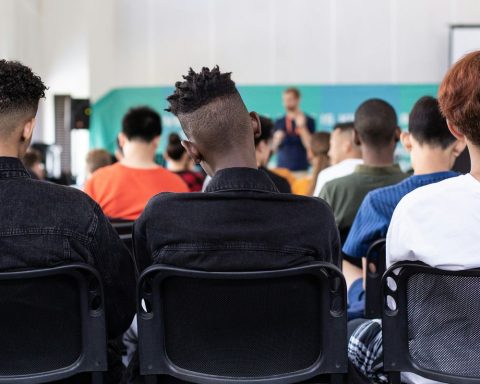

The scene repeats itself every day, from Monday to Friday. Around 11 am, there is an uproar on a stretch of Senado Street, in the center of Rio 
 of January. Dozens of people, sitting or lying on the sidewalk, protected by trees and a bus shelter, run to form a line when they see volunteers come out of number 50.
of January. Dozens of people, sitting or lying on the sidewalk, protected by trees and a bus shelter, run to form a line when they see volunteers come out of number 50.
Confusion is inevitable. Those who arrived later 
 try to position themselves ahead of those who were there early on and organize themselves, even if
try to position themselves ahead of those who were there early on and organize themselves, even if 
 precariously. Meanwhile, volunteers from number 50 write down the names of those who ran to the queue.
precariously. Meanwhile, volunteers from number 50 write down the names of those who ran to the queue.
Only 100 of the many homeless people who live on the street will be selected that day and given a lunch, offered free of charge by the non-governmental organization Fraternidade sem Fronteiras. The NGO has been operating there, at number 50, for almost two years.
For some of them, that will be their only meal of the day, if they’re lucky. Marcelo, 41 years old, was one of the first in the “hunger queue” on the morning of the first Thursday of March (2). Unemployed since leaving jail in 2019, on parole, he depends on other people’s goodwill to eat.
At night, he manages to have dinner at a city hall shelter, but during the day he has to fight for his meal. “I fought with my brothers and had to leave the house. I’ve been on the street for a year and six months. It’s a complicated situation, because we don’t have money. So you have to run where there is food”, said Marcelo to Brazil Agency.
Also in line, Márcio, 39, had to leave the house where he lived with his wife and five children, three months ago, because he was a drug user. He says he is “free of addiction”, but, unemployed and living on the street, he has a daily struggle to be able to feed himself. “Sometimes we manage to eat in the shelters, sometimes some churches also give. We survive with the help of others.”
Paulo César, 27 years old, three of them living on the street after being expelled from his community by criminals, also got his lunch last week 
 Thursday. But it’s not always so.
Thursday. But it’s not always so. 
 Saturday
Saturday 
 It is
It is 
 Sunday
Sunday 
 there is no lunch at the NGO. And sometimes, even during the week, you are not lucky enough to be among the selected ones.
there is no lunch at the NGO. And sometimes, even during the week, you are not lucky enough to be among the selected ones.
“I’m on this route every day here. Sometimes when there is not enough here, you have to run after it. Then you go to the Central, sometimes you get it there. When they don’t have it, everything falls apart. You have to keep digging in the market, when there is surplus, or else in the salty stores, when you throw it in the trash, we go there and pick it up. I have already gone two days without eating, ”she recalled.
The idea of offering lunch to the street population came about during the covid-19 pandemic, according to the project coordinator, Isabel Silveira.
“How can you do anything on an empty stomach? Food is a possibility to guarantee the first basic human need. From the moment they are feeding, we can build other issues”.
The “hunger queue” is just one example of the problem of food insecurity in large Brazilian cities.
food insecurity
According to a survey by the Brazilian Research Network on Food and Nutritional Sovereignty and Security (Penssan) carried out with 35,000 respondents and released in 2022, 57.8% of the country’s urban population face some degree of food insecurity, that is, they do not eat way they should. At least 15% are in a situation of serious insecurity, which means that millions of people suffer from hunger in Brazil.
The national secretary for Food and Nutrition Security, Lilian Rahal, points out that the city is where most of the population facing hunger is concentrated. “Data from the Penssan Network show that, in percentage terms, there is more hunger in the [espaço] rural than in the urban. But numerically there are many more people in the cities going hungry than in the countryside”.
So it’s not just homeless people who have to deal with the problem. Study 
 carried out by the Central Única das Favelas (Cufa) and by the Locomotiva Institute, in February 2021, with
carried out by the Central Única das Favelas (Cufa) and by the Locomotiva Institute, in February 2021, with 
 2,087 residents of 76
2,087 residents of 76 
 Brazilian favelas, showed that 68% of respondents did not have money to buy food on at least one day in the two weeks prior to the survey.
Brazilian favelas, showed that 68% of respondents did not have money to buy food on at least one day in the two weeks prior to the survey. 

“Homeless people are the most extreme, unacceptable and inhumane side of hunger. But there are also situations where people [que têm casa] who eat less than they should because of difficulty in accessing food. There are people who restrict food for a few days so that this food can last for the whole month, until the next moment when it is possible to buy this food again. These are situations that reflect hunger in some way,” said the researcher from the Institute of Nutrition at the Federal University of Rio de Janeiro.
of January
(UFRJ) Juliana Lignani.
According to her, food insecurity stems from inequalities, whether in terms of income, housing, gender or race. “These are situations that will lead to difficulty in accessing food. It may be a difficulty of financial access. They are people who can’t 
 to have
to have 
 sufficient income to purchase this food adequately. There may also be a physical access difficulty. These are people who live in certain regions that make it difficult to access food,” he explained.
sufficient income to purchase this food adequately. There may also be a physical access difficulty. These are people who live in certain regions that make it difficult to access food,” he explained.
The researcher claims that factors such as precarious jobs and the type of family arrangement can also be problems for proper nutrition. Families with many children or teenagers, for example, find it more difficult.
“These are residents who demand income and, most of the time, do not contribute to the income. And we even expect that to happen, since children shouldn’t work.”
Juliana Lignani explains that resolving the issue of hunger is not simple and requires policies that go beyond government income transfer programs.
“We need to work on the structural issues that lead to this scenario. At the same time, there should be emergency policies, such as income transfers, which will remedy 
 at the moment, but we also need structural policies that will solve the causes of this problem, such as
at the moment, but we also need structural policies that will solve the causes of this problem, such as 
 increase in formal jobs and supply in large cities so that this food can reach the population more easily.”
increase in formal jobs and supply in large cities so that this food can reach the population more easily.”
The secretary of Food Security, Lilian Rahal, affirms that the strategies of the federal government 
 include “broad public policies”, such as increasing the production of basic foodstuffs, actions to make meals available by municipalities, guaranteeing the arrival of food to places with the highest rates of malnutrition, increasing family incomes, recovering the power of purchase of the minimum wage, the generation of jobs and the strengthening of the National School Feeding Program (Pnae).
include “broad public policies”, such as increasing the production of basic foodstuffs, actions to make meals available by municipalities, guaranteeing the arrival of food to places with the highest rates of malnutrition, increasing family incomes, recovering the power of purchase of the minimum wage, the generation of jobs and the strengthening of the National School Feeding Program (Pnae).
In addition, according to her, the government wants to reinforce the Food Acquisition Program (PAA), which encourages the purchase of food produced by small producers and family farmers, through the recovery of the 
 budget and reformulation, ensuring that food reaches the most vulnerable families, including cities.
budget and reformulation, ensuring that food reaches the most vulnerable families, including cities.
“That the distribution [desses alimentos] arrive more and more for those who are starving, for families and regions with higher indicators of malnutrition and for equipment that offers meals for those who are starving in the periphery or in the big cities”, he highlighted.





















